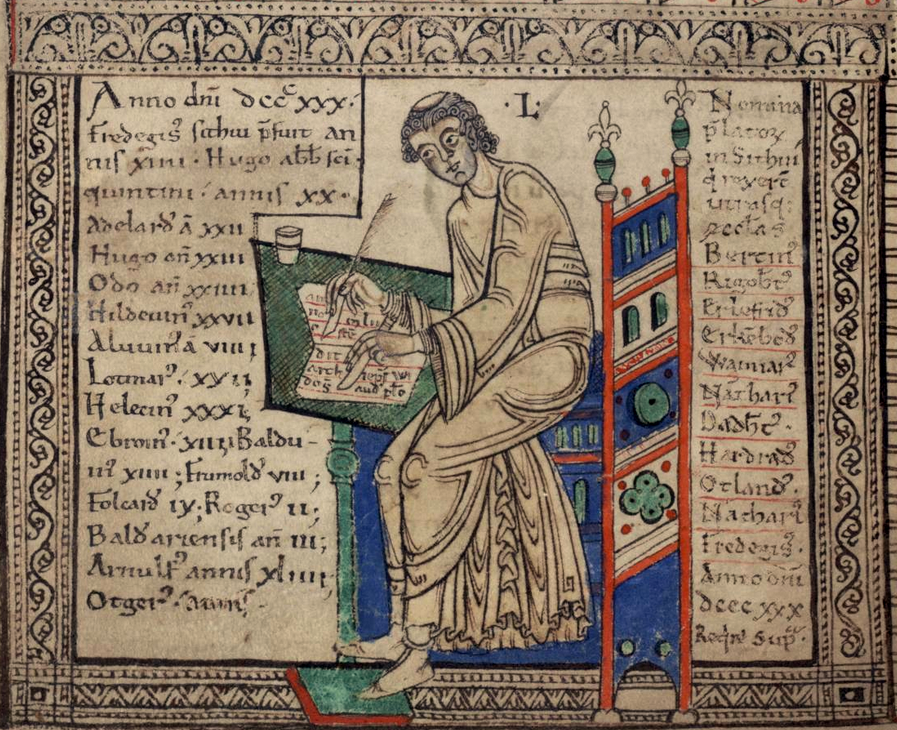What Is Copyright?
Learning Objectives
By the end of this chapter, you will be able to
- Describe the basic rights involved in copyright.
- Give examples of what kinds of works are copyrighted.
- Explain how works are copyrighted.
At one time, copies of texts were made by hand.

The emergence of the moveable-type printing press in the sixteenth century made the mass reproduction of text and images possible. Many more copies of texts and images could be made in a short time! Less than two centuries later, in 1710, the first copyright law was enacted in England. This law began the process of legally defining who could make copies of what, and how, when, and for what purposes those copies could be made.
Questions and Answers About Copyright
Now that almost everything we do online involves making a copy, copyright is a regular feature in our lives. But you might have questions about what can be copyrighted and who controls the rights to a copyrighted work. Here are some questions you might have—and their answers. Note that what follows is a very basic introduction to a complex area of law; none of it should be taken as legal advice.
What rights are involved in copyright?
Copyright grants a set of exclusive rights to copyright owners, which means that no one else can copy, distribute, publicly perform, adapt, or do almost anything else other than simply view or read the work without permission of the copyright holder.
What kinds of works can be copyrighted?
Copyright grants rights to literary and artistic works that are original. Copyright is available to everything from paintings to blog posts, but all works must meet a certain standard of originality to warrant copyright. Generally speaking, this means the work must have been a creation of its creator and not copied from another work.
Can ideas be copyrighted?
Copyright does not protect facts or ideas themselves, only the expression of those facts or ideas. The difference between an idea and the expression of that idea can be tricky, but it’s also quite important to understand. While copyright law gives creators control over their expression of an idea, it does not allow the copyright holder to own or exclusively control the idea itself.
How can I claim copyright over my works?
As a general rule, copyright is automatic the moment a work is created, though some countries, such as the United States, require that the work be fixed in a tangible medium before granting copyright. In other words, in the United States, you can’t claim copyright for the idea for an image; you can claim copyright only for an image that has been fixed in some way—rendered as a photograph, sketch, painting, etc.
Registration with the local copyright office is not required to gain copyright protection.
How long does copyright last?
Copyright protection lasts a long time, often many decades after the creator dies.
Is the author or creator always the person who holds the copyright for a work?
Typically, the first owner of a copyright will be the individual person that created a work. However, the exclusive rights granted by copyright can be transferred to others, including legal entities such as corporations, publishers, or universities. Understanding who controls the exclusive rights granted by copyright is necessary in order to understand who has authority to grant permissions to others to reuse the work (e.g., adding a CC license to the work).
However, it is important to note that the author of a work may not necessarily be the copyright holder. For example, works created in the course of your employment are likely to be owned by your employer, though ownership rules vary by jurisdiction. Similarly, depending on the terms of their contract, independent contractors may or may not own and control copyright in the works they create in that capacity. Additionally, teachers, university faculty, and learners may or may not own and control copyright in the works they create in those capacities.
At CUNY, students own the copyright to their work.
What else should I know about copyright?
Copyright protection is balanced against other public interests. The rights granted to copyright owners may be considered against other public interests, such as freedom of expression rights, the right to access information, and the needs of people with disabilities. There are occasions when copyright protections may be limited to serve the public interest. See the chapter in this guide on fair use for more information on these limitations to copyright protection.
Attribution
This chapter is excerpted from 2.1 Copyright Basics by Creative Commons, licensed CC BY 4.0. The learning objectives, introductory text, and question-and-answer format are original to this version.
